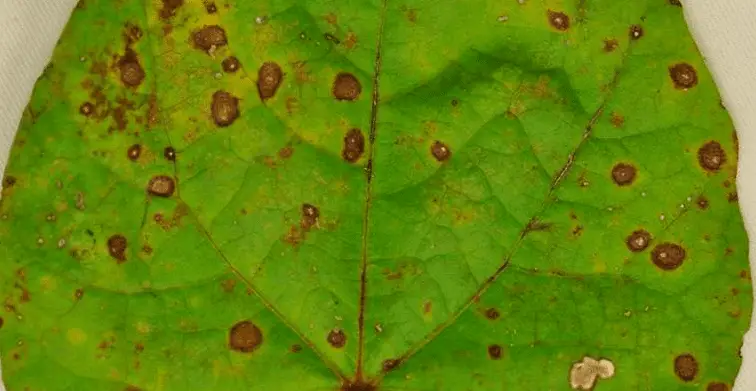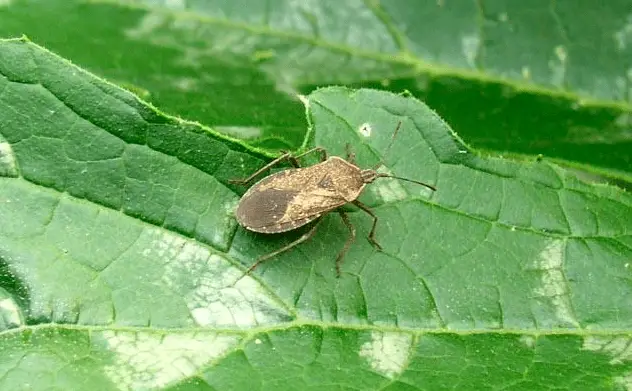Have you been noticing that your cantaloupe leaves have been turning brown? If so, don’t worry – you’re not alone. This is a common problem with this type of fruit, and there are several things that you can do to prevent it from happening.
In this blog post, we will discuss the causes of leaf browning in cantaloupes, as well as some tips on how to fix the problem.
Why Are My Cantaloupe Leaves Turning Brown?
The most common causes of leaf browning in cantaloupes are fungal diseases, pests, watering issues, and leaf burn. Each cause will give a different type of browning pattern on the leaves.
It’s important to identify the cause of the problem so that you can take the appropriate steps to fix it. I will now go over each of the causes in more detail.
Browning Cantaloupe Leaves from Fungal Infection
One of the most common reasons for browning leaves is a fungal infection. The two most common types of fungi that affect cantaloupes are Alternaria leaf blight and cercospora leaf spot.
1) Alternaria leaf blight
This type of fungus affects the leaves, stems, and fruit of the plant. The symptoms include small yellow-brown patches that get larger and turn darker brown or black. The leaf tissue will eventually die, and the leaves will drop off.
2) Cercospora leaf spot
This type of fungus lives on debris and is spread by wind and rain. The symptoms include small brown spots that spread quickly. This leaf spot disease highlights the importance of keeping your garden free of debris.
The first step to preventing these fungal diseases is to keep water off of the leaves. Water on the leaves creates a perfect environment for fungi to grow. Be sure to water at the base of the plant and not overhead.
The second step is to remove any affected leaves from the plant. This will help prevent the spread of the disease. Dispose of them far away from the cantaloupe patch so that the fungi don’t come back or spread.
The third step is to use a fungicide. Be sure to read the label carefully and follow the instructions. You should apply the fungicide at the first sign of disease and then again every seven to fourteen days.
Neem oil is my favorite type of fungicide because it’s natural, safe to use, and effective for both fungal diseases and pests.

Browning Cantaloupe Leaves from Too Much Water
Like with most plants, too much water can cause problems for cantaloupes. When the leaves are constantly wet, it creates an environment that is perfect for fungi to grow. The leaves will start to turn yellow and then brown.
If you think that your cantaloupe plants are getting too much water, the first step is to check the drainage. Make sure that there is good drainage in the area where you’re growing them. If not, consider raised beds or containers.
The second step is to reduce how often you’re watering. Cantaloupes need about one inch of water per week. If it’s been raining a lot, you may not need to water them at all! Let the rain do its job.
The third step is to water at the base of the plant and not overhead. This will help keep the leaves dry and prevent fungi from growing.
Browning Cantaloupe Leaves from Pests
Pests love eating cantaloupe leaves! The most common pests are aphids, cucumber beetles, and squash bugs.
Aphids
These small insects suck the sap out of the leaves, causing them to turn yellow and then brown. They also spread diseases, so it’s important to get rid of them as soon as possible.
Cucumber beetles
These striped bugs eat the leaves and flowers of cantaloupes. The damage they cause can stunt the growth of the plant or kill it entirely.
Squash bugs
Like cucumber beetles, squash bugs eat the leaves and flowers of cantaloupes. They like living in amongst lead debris, so keeping your garden clean is the best way to prevent them.
The best way to get rid of pests is to use a pesticide. Be sure to read the label carefully and follow the instructions. You should apply the pesticide at the first sign of pests and keep going until they’re all gone.
Again, neem oil is my favorite type of pesticide because it’s one of the most effective and it’s also safe to use. It works by suffocating the pests and disrupting their life cycle.

Browning Cantaloupe Leaves from Leaf Burn
Too much sun can cause the leaves of cantaloupes to turn brown. This is called leaf burn and it’s a common problem in hot, sunny climates. The leaves will be crispy and brown on the edges, which is in contrast to the browning caused by too much water or infection.
If you live in a hot, sunny climate, it’s important to keep an eye on your cantaloupe plants and look for signs of leaf burn. If you see any browning, take action to provide some shade and reduce the amount of water they’re getting.
The best way to prevent leaf burn is to provide some shade for your plants. This can be done by planting them in an area that gets partial sun or by using a tarp or other type of shading material.
If the leaves are already brown, you can try trimming them off. This will help the plant focus its energy on new growth. You can also try moving the plant to a shadier spot.
Browning Cantaloupe Leaves FAQs
This plant isn’t the easiest to take care of. I have compiled a list of the most frequently asked questions when it comes to browning leaves on a cantaloupe plant.
Will brown cantaloupe leaves turn green again?
No, unfortunately, once the leaves have turned brown, there is no coming back. The best thing to do is to focus on preventing further damage and encouraging new growth.
Should I remove brown leaves from my cantaloupe?
Yes, you should remove brown leaves from your plant. This will help the plant focus its energy on new growth. Simply cut the leaves off at the stem using a pair of sharp scissors that have been disinfected.
Conclusion
The leaves of cantaloupes are susceptible to a number of problems, including fungal diseases, too much water, pests, and leaf burn. The best way to prevent these problems is to be proactive.
Water at the base of the plant, remove affected leaves, use a fungicide or pesticide, and provide some shade if needed. With proper care, your cantaloupe plants will thrive!
Tim is an avid gardener from the UK. He was the founder of PlantCarer.com from 2021 to Sep 2023. He sold PlantCarer.com to Aaron. He has since started his own business called Seed To Supper, which provides new gardeners all the materials you need in a box (pots, seeds, compost and instructions) to grow your own delicious and nutritious vegetables and herbs from start to finish – no garden required.









0 Comments